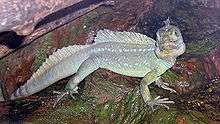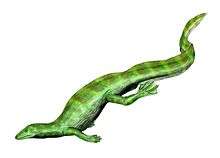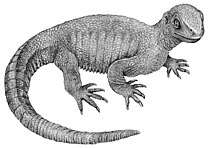Lepidosauromorpha
Lepidosauromorpha is a group of reptiles comprising all diapsids closer to lizards than to archosaurs (which include crocodiles and birds). The only living sub-group is the Lepidosauria: extant lizards, snakes and tuataras.
| Lepidosauromorphs | |
|---|---|
 | |
| A plumed basilisk | |
| Scientific classification | |
| Kingdom: | Animalia |
| Phylum: | Chordata |
| Class: | Reptilia |
| Clade: | Sauria |
| Clade: | Lepidosauromorpha Benton, 1983 |
| Subgroups[2] | |
| |
| Synonyms | |
|
Ankylopoda (obsolete clade) | |
Lepidosauromorpha are distinguishable from Archosauromorphs (archosaurs) by their primitive sprawling gait, which allows for the same sinusoidal trunk and tail movement seen in fish, the sliding "joint" between the coracoids and the sternum (for a longer stride), and their pleurodont dentition. In contrast, Archosauromorphs possess a parasagittal gait, a reduction in their dermal girdle, a reduction and/or loss of the sternum, and a more thecodont dentition.
Lepidosauromorpha have retained cold blood because of their low-energy sprawling stance.
References
- Jones, M. E.; Anderson, C.; Hipsley, C. A.; Müller, J.; Evans, S. E.; Schoch, R. R. (2013). "Integration of molecules and new fossils supports a Triassic origin for Lepidosauria (lizards, snakes, and tuatara)". BMC Evolutionary Biology. 13: 208. doi:10.1186/1471-2148-13-208. PMC 4016551. PMID 24063680.
- Susan E. Evans and Magdalena Borsuk−Białynicka (2009). "A small lepidosauromorph reptile from the Early Triassic of Poland" (PDF). Paleontologica Polonica. 65: 179–202.




